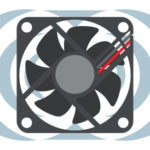When an end system produces excess heat, designers commonly turn to dc fans to provide forced-air cooling for improved heat dissipation. Based on the well-known thermal-convection principle, forced air cooling should typically go beyond simply selecting a fan and running it full-time in your application. This full-time operation suffers from both its inefficiency and long-term reliability. On/off control is a step in the right direction, but even its approach can be too simplistic and introduce problems such as thermal cycling and thermal overshoot.
This is why many of today’s designs implement the more advanced controls and protections offered by dc fans. Some of the most common include pulse-width modulation (PWM), embedded tachometer signal, auto-restart protection, and rotation detection, all of which can contribute to better system efficiency and reliability.
The CUI Insights™ blog post, “Cooling Fans: Monitoring, Control, and Protection Enhance System Performance” further outlines these dc fan controls and protections and discusses the shortfalls of other design approaches.





Leave a Reply